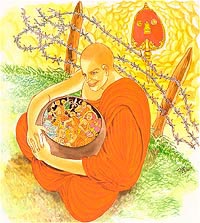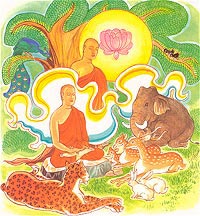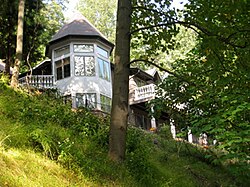sabbe satta bhavantu sukhi-tatta
TIPITAKA
TIPITAKA AND TWELVE DIVISIONS
Brief historical background
Sutta Pitaka
Vinaya Pitaka
Abhidhamma Pitaka
Twelve Divisions of Buddhist Canons
Nine Divisions of Buddhist Canons
Sutta Piṭaka
— The basket of discourses —Mahāsatipaṭṭhāna Sutta (DN 22) {excerpt} - all infobubbles— Attendance on awareness —Kāyānupassanā
DhammapadaVerses 264 and 265 Hatthaka Vatthu-Verse 264. Shaven Head Alone Does Not Make A MonkVerse 265. Who Give Up Evil Is True Monk
New Jersey
Soshimsa
• So Shim Sa Zen Center
 |
Verse 264. Shaven Head Alone Does Not Make A Monk
Explanation: Can an individual who does not practice religion, |
 |
Verse 265. Who Give Up Evil Is True Monk
Explanation: If an individual were to quell all defilements, |
Dhammapada Verses 264 and 265
Hatthaka Vatthu
Na mundakena samano
abbato alikam bhanam
icchalobhasamapanno
samano kim bhavissati.
Yo ca sameti papani
anumthulani sabbaso
samitatta hi papanam
“samano” ti pavuccati.
Verse 264: Not by a shaven head does a man become a samana, if he lacks
morality and austere practices and tells lies. How could he who is full of
covetousness and greed be a samana?
Verse 265: He who has totally subdued all evil, great and small, is called a
samana because he has overcome all evil.
The Story of Bhikkhu Hatthaka
While residing at the Jetavana monastery, the Buddha uttered Verses (264) and
(265) of this book, with reference to a bhikkhu named Hatthaka.
Bhikkhu Hatthaka was in the habit of challenging ascetics of non-Buddhist
faiths to meet him in a certain place to debate on religious matters. He would
then go out by himself to the self-appointed place. When nobody appeared he
would boast, “Look, those wandering ascetics dare not meet me, they have
been beaten by me!”, and such other things. The Buddha called Hatthaka to
him and said, “Bhikkhu! Why do you behave in this way? One who says such
things cannot become a samana in spite of his shaven head. Only one who has rid
himself of all evil is to be called a samana.”
Then the Buddha spoke in verse as follows:
|
Verse 264: Not by a shaven head does a man become |
|
Verse 265: He who has totally subdued all evil, |
New Jersey
Soshimsa
• So Shim Sa Zen Center
http://en.wikipedia.org/wiki/So_Shim_Sa_Zen_Center
| So Shim Sa Zen Center | |
|---|---|
 |
|
| Information | |
| Denomination | Seon, Korean Zen |
| Founder(s) | Il-Cho Bobsanim |
| Director(s) | Dir. of Wellness: Ven. Mooh-Sang Dir. of Outreach: Ven. Duhk-Song |
| Abbot(s) | Ven. Myong-Ahn |
| Address | 123 Morning Glory Rd Warren, New Jersey |
| Country | United States |
| Website | soshimsa.org |
So Shim Sa Zen Center ( Hangul: 소심사 Hanja: 少心寺) is a Buddhist organization in New Jersey affiliated with the Taego Order of Korean Zen.[1]
Contents
http://www.examiner.com/article/buddhist-stories-for-children-for-free Buddhist stories for children - for free
There is a large collection of Buddhist stories that are popular with children. These stories are called the Jataka Tales (Wikipedia). The Buddha
Through the wonders of the Internet, you can access and download texts and videos for free to enjoy these ancient stories and, if you feel they are appropriate, to share them with your children. Jataka Tales on video
from short cartoons of the stories to a teaching by the Dalai Lama over ninety minutes long.
Jataka Tales By Ellen C. Babbitt - This is a Google book of modern versions of the stories. Jataka Tales Jataka Tales of the Buddha, retold by Ken & Visakha Kawasaki - These are modern retellings of stories from the Cowell edition. Jataka Tales to download
Buddhist Tales for Young & Old, Volume I Buddhist Tales for Young & Old, Volume II http://www.sacred-texts.com/bud/index.htm#jataka http://books.google.com/books?id=Xpbx97xn_7gC&dq=jataka+tales&printsec=frontcover&source=bn&hl=en&ei=zXMxS-iZJsaVtgfFn-2FCQ&sa=X&oi=book_result&ct=result&resnum=6&ved=0CB8Q6AEwBQ#v=onepage&q&f=false http://www.accesstoinsight.org/lib/authors/kawasaki/index.html http://www.mainlesson.com/display.php?author=babbitt&book=morejataka&story=_contents THE GIRL MONKEY AND THE STRING OF PEARLS[3]
NE day the king went for a long walk in the woods.
When they were all ready to go into the water,
As the queen put her string of pearls away in a box,
At first the servant kept her eyes on the jewel-box.
[4] As soon as the Monkey saw this,
By and by the servant awoke. She looked in the box, Up ran the guards from every side.
The servant said: “I sat right here beside the box The guards told the king that the pearls were gone.
“Find the man who stole the pearls,” said the king. After the king had gone, the chief guard said to himself:
“There is something strange here. These pearls,” thought he,
Then the chief guard thought of a trick
After dark that night the guards hung the strings of glass beads
But the Girl Monkey who had taken the queen’s string
The other Monkeys were greatly pleased with their strings of beads.
Then the chief of the guards, who had been hiding near-by, “It was this Girl Monkey, your Majesty, who took the pearls.”
[7] The king was glad enough to get the pearls,
The chief guard told the king
“You are the right man in the right place,”
![[Illustration]](http://www.mainlesson.com/books/babbitt/morejataka/zpage007.gif) |
http://www.nj.com/comics-kingdom/?feature_id=Family_Circus
-
About Family Circus
Bil Keane’s warm, humorous portraits of
the intimate moments in family life, based on his own real-life family
circus, have charmed readers around the world since 1960. Today, The
Family Circus is the most widely syndicated comic panel in the world,
appearing in 1,500 newspapers. The daily panels are routinely drawn
within a circle, meant to underscore the sense of closeness between the
characters. More than 60 collections of the cartoons have been
published, and the panel’s characters have inspired three TV specials
and appeared in a wide variety of educational and public-service
projects.While Keane’s cartoon kids have stayed the same age,
his real kids have grown up and two followed in their father’s creative
footsteps. Glen, who served as the model for the Billy character, is now
a prominent animator for The Walt Disney Company. He designed and
animated the Beast for Disney’s “Beauty and the Beast” and most recently
did the brilliant animation on Tarzan. Jeff works as his dad’s
assistant on the comic panel. And today, nine grandchildren provide the
cartoonist with a whole new generation of ideas.Author(s)

Cheney may have shot that man in the face, but at least he didn’t call him an idiot.


![[Illustration]](http://www.mainlesson.com/books/babbitt/morejataka/zpage005.gif)




